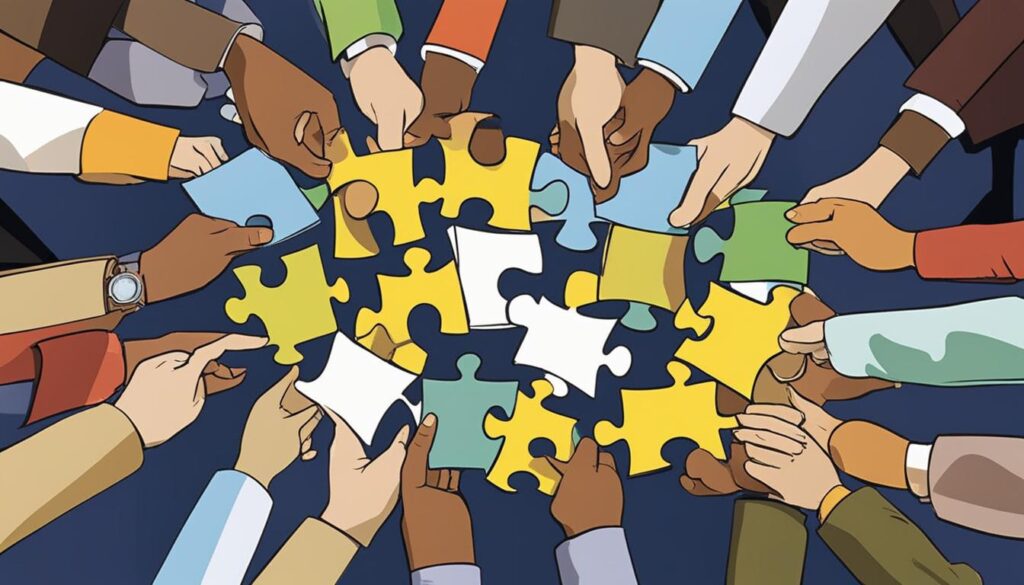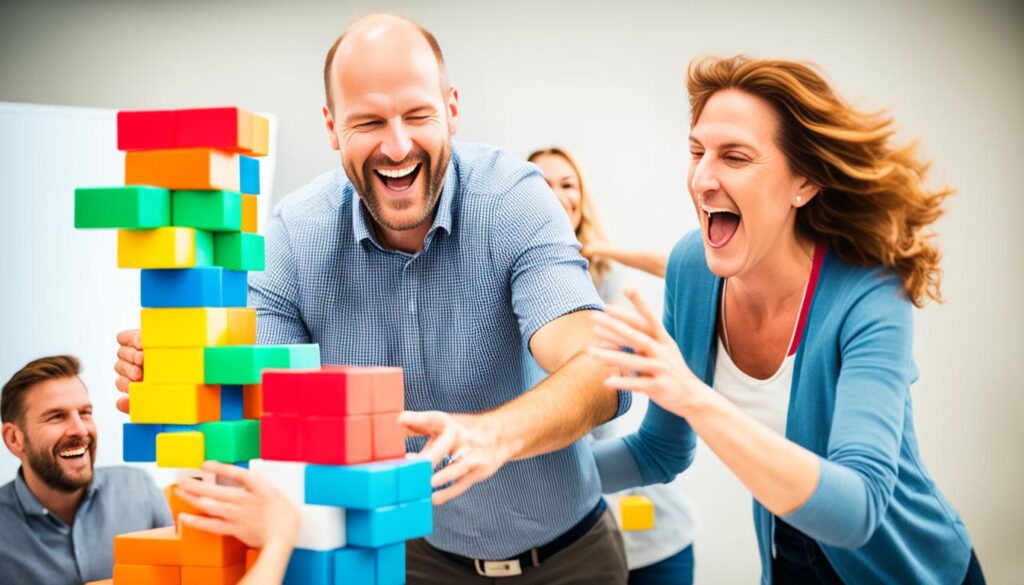Building and maintaining strong team dynamics is essential for success in any industry. Effective team dynamics can lead to increased productivity, improved decision-making, and better collaboration among team members. But how do companies create and foster a positive team dynamic?
Let me share a story that illustrates the importance of team dynamics in a company. Imagine a software development company called TechSolutions. They had a team of talented developers who were individually skilled but struggled to work together effectively. The lack of coordination and communication resulted in missed deadlines, reduced quality of work, and frustrated clients.
Realizing that the team dynamics were hindering their progress, TechSolutions decided to take action. They invested in team building activities to improve communication and build trust among team members. They organized workshops where team members engaged in collaborative problem-solving and shared their ideas openly.
The results were remarkable. As team members got to know one another better, they started appreciating each other’s strengths and working together more effectively. They established clear goals and held regular meetings to discuss progress and address any challenges. The improved team dynamic not only enhanced productivity but also motivated team members to support and encourage each other.
Through their efforts to build strong team dynamics, TechSolutions transformed their work environment. Team members began to feel valued and recognized for their contributions, leading to increased job satisfaction and reduced turnover.
Creating and fostering effective team dynamics can significantly impact a company’s success. It requires effort and investment but can lead to a more cohesive and productive team.
Key Takeaways:
- Effective team dynamics are crucial for achieving organizational goals and desired outcomes.
- Building strong team dynamics requires open communication, trust, and collaboration among team members.
- Investing in team building activities can improve communication, build trust, and enhance teamwork skills.
- Effective leadership plays a vital role in shaping and maintaining positive team dynamics.
- Fostering a positive work environment and promoting diversity can contribute to stronger team dynamics.
Understanding Team Dynamics
Team dynamics refer to the interactions, relationships, and communication patterns among team members. It involves how individuals work together to achieve a common goal, make decisions, and solve problems. Effective team dynamics can significantly enhance productivity and foster a positive work environment, leading to greater job satisfaction among team members. However, challenges such as conflict, miscommunication, or differing work styles can hinder collaboration and impede progress. Team dynamics center caps explained, play a crucial role in understanding how to navigate these challenges, ensuring that all voices are heard and that the team’s collective strengths are leveraged for optimal outcomes. Effective team dynamics require collaboration, trust, open communication, and a clear understanding of individual roles and responsibilities. When team members work well together, they can achieve more than they would individually.
Factors influencing team dynamics include team size, diversity, leadership style, and external factors such as market trends and competition. A diverse team brings together different perspectives and skill sets, leading to better problem-solving and innovation. Communication plays a critical role in team dynamics, fostering effective collaboration and enhancing the overall performance of the team.
Effective team communication involves active listening, clarity, and respect for individual opinions. It is important to establish open channels of communication, ensuring that team members have the opportunity to voice their ideas and concerns. Regular team meetings and check-ins can provide a platform for discussion and alignment. In addition, technology tools such as project management software, messaging apps, and video conferencing platforms can facilitate seamless communication and collaboration among team members, especially in remote or distributed teams.
“Teamwork is the ability to work together toward a common vision. The ability to direct individual accomplishments toward organizational objectives. It is the fuel that allows common people to attain uncommon results.” -Andrew Carnegie
Building strong teamwork skills is essential for effective team dynamics. It involves developing a shared sense of purpose, trust, and understanding among team members. Team building activities, both formal and informal, can help foster a sense of camaraderie and create opportunities for collaboration. Encouraging a positive and inclusive work environment where team members feel valued and supported can also contribute to stronger teamwork skills.
| Key Elements of Effective Team Dynamics | Benefits |
|---|---|
| Collaboration | – Improved problem-solving – Enhanced creativity and innovation – Increased efficiency and productivity – Shared learning and growth opportunities |
| Trust | – Greater synergy and cooperation – Increased transparency and honesty – Improved decision-making and risk-taking – Stronger relationships and morale |
| Open Communication | – Clear understanding of goals and expectations – Effective conflict resolution – Increased knowledge-sharing and feedback – Greater alignment and coordination |
| Understanding Roles and Responsibilities | – Reduced overlap and redundancy – Enhanced task allocation and accountability – Improved decision-making and planning – Clearer expectations and performance standards |
The Role of Leadership in Team Dynamics
Effective leaders play a vital role in shaping team dynamics. They provide guidance, support, and clear expectations to team members, ensuring that everyone knows their role and has the necessary skills and resources to succeed. With strong leadership, team members feel empowered to contribute their ideas and opinions, fostering open communication and collaboration.
“Leadership is not about being in charge. It is about taking care of those in your charge.” – Simon Sinek
Accountability is another crucial aspect of leadership in team dynamics. Leaders should address underperformance and hold team members accountable for their actions. By setting high standards and expectations, leaders create a culture of excellence and encourage individuals to take ownership of their work.
Leaders also play a significant role in creating a positive work environment. By promoting fairness, respect, and trust, leaders can enhance team dynamics and improve overall performance. They should foster a sense of belonging and provide opportunities for growth and development, motivating team members to reach their full potential.
“Great leaders are willing to sacrifice their personal interests for the good of the team.” – John Wooden
Leadership in team dynamics is not just about overseeing tasks and managing people. It’s about inspiring and influencing others to achieve shared goals and objectives. By embodying the qualities of a strong leader, individuals can drive team performance, foster collaboration, and create a culture of accountability and success.
To further explore the importance of leadership in team dynamics, let’s examine a real-world example:
| Company | Leadership Style | Team Performance |
|---|---|---|
| Apple Inc. | Steve Jobs | Apple’s success can be attributed to Steve Jobs’ visionary leadership style. His attention to detail, passion, and ability to inspire his team members led to the creation of revolutionary products and a strong company culture. |

Steve Jobs demonstrated the significance of leadership in team dynamics through his relentless pursuit of excellence. His emphasis on innovation, accountability, and collaboration propelled Apple to become one of the most valuable and influential companies in the world.
In conclusion, leadership plays a critical role in shaping team dynamics. Effective leaders provide guidance, support accountability, and foster a positive work environment. By embodying strong leadership qualities, individuals can enhance team performance, improve collaboration, and drive organizational success.
Best Practices for Fostering Positive Team Dynamics
Fostering positive team dynamics is vital for the success of any organization. By implementing best practices, companies can create a collaborative and supportive work environment that enhances productivity and drives innovation. In this section, we will explore several key strategies for fostering positive team dynamics.
Establishing Clear Goals
Establishing clear goals is the foundation for effective team dynamics. When team members have a shared understanding of the organization’s objectives, they can align their efforts toward achieving those goals. Clear goals provide direction, set expectations, and enable team members to prioritize their tasks. This clarity fosters a sense of purpose and unity among team members.
Encouraging Open Communication
Open communication is essential for effective team dynamics. When team members feel comfortable expressing their ideas, concerns, and feedback, it fosters a culture of transparency and trust. Encouraging open communication creates opportunities for collaboration, problem-solving, and learning from one another’s experiences. It also helps resolve conflicts and prevents misunderstandings that can hinder teamwork.
Promoting Diversity
Promoting diversity within teams is key to fostering positive team dynamics. Diverse teams bring together individuals with different backgrounds, perspectives, and expertise. This diversity sparks creativity, innovation, and critical thinking. By promoting diversity, organizations can create an inclusive work environment where all team members feel valued and empowered to contribute their unique insights and skills.
Team Building Activities
Team building activities play a crucial role in strengthening team dynamics. These activities create opportunities for team members to bond, build trust, and improve communication. Whether it’s a team retreat, a fun team-building exercise, or a collaborative project, these activities help break down barriers and forge stronger relationships among team members. They also provide a platform for team members to develop problem-solving skills, enhance collaboration, and boost morale.
By implementing these best practices, organizations can foster positive team dynamics and create an environment where teams thrive. The next section will provide a real-world example of a company that successfully implements these strategies to build strong team dynamics.

Conclusion
Improving team dynamics is crucial for enhancing teamwork skills and ultimately improving overall team performance. By understanding the factors that influence team dynamics, such as team size, diversity, and leadership style, organizations can take proactive steps to create a positive work environment and foster effective collaboration.
A key component of enhancing team dynamics is the role of leadership. Effective leaders provide guidance, support, and clear expectations to their team members. They encourage open communication, address underperformance, and hold individuals accountable for their actions. By creating a culture of trust and providing opportunities for growth and development, leaders can enhance team dynamics and drive team success.
To cultivate strong and cohesive teams, it is important for organizations to establish clear goals, promote open communication, and encourage diversity. This fosters an inclusive work environment where diverse perspectives are valued and team members feel comfortable contributing their ideas. Team building activities can also play a crucial role in strengthening relationships and building trust among team members.
In conclusion, investing in improving team dynamics leads to improved teamwork skills, enhanced team performance, and increased productivity. By implementing best practices and addressing challenges as they arise, organizations can create a supportive and collaborative work environment that benefits both the individuals and the organization as a whole.
FAQ
What are team dynamics?
Team dynamics refer to the interactions, relationships, and communication patterns among team members. It involves how individuals work together to achieve a common goal, make decisions, and solve problems.
What factors influence team dynamics?
Factors influencing team dynamics include team size, diversity, leadership style, and external factors such as market trends and competition.
What is the role of leadership in team dynamics?
Effective leaders play a vital role in shaping team dynamics. They provide guidance, support, and clear expectations to team members. They should ensure that everyone knows their role, has the necessary skills and resources, and encourage open communication and collaboration.
How can I foster positive team dynamics?
Fostering positive team dynamics requires implementing best practices. It is important to establish clear goals and expectations, ensuring that team members understand their roles in achieving those goals. Open communication and trust are crucial for effective team dynamics. Encouraging diverse perspectives and creating an inclusive work environment can spark creativity and enhance collaboration. Team building activities can help build trust and strengthen relationships among team members.
Why is improving team dynamics important?
Improving team dynamics is essential for enhancing teamwork skills and improving overall team performance. It requires understanding the factors influencing team dynamics, the role of leadership, and implementing best practices. By fostering a positive work environment, promoting open communication, and providing opportunities for growth and development, companies can create a strong and cohesive team. Moreover, conducting regular evaluations through effective team dynamics analysis can help identify areas for improvement and potential conflicts before they escalate. This proactive approach not only strengthens relationships among team members but also aligns their goals towards shared objectives. Ultimately, by prioritizing effective team dynamics, organizations enable their teams to navigate challenges more efficiently, resulting in enhanced creativity and productivity.


